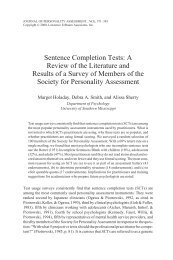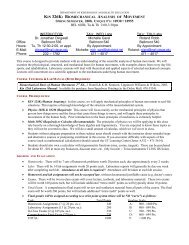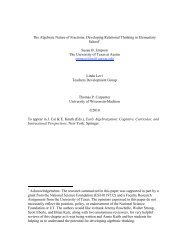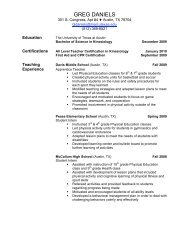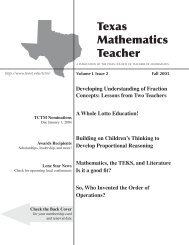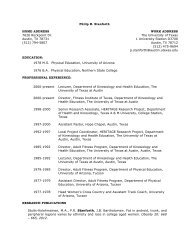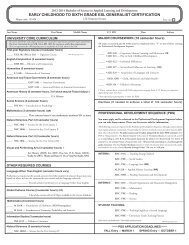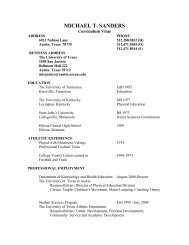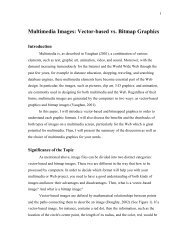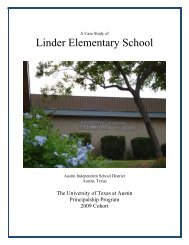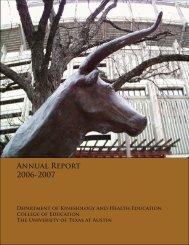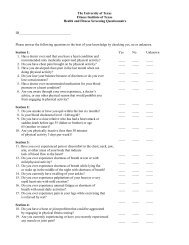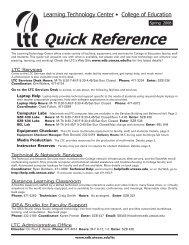High Schools: Size Does Matter - The College of Education - The ...
High Schools: Size Does Matter - The College of Education - The ...
High Schools: Size Does Matter - The College of Education - The ...
Create successful ePaper yourself
Turn your PDF publications into a flip-book with our unique Google optimized e-Paper software.
Issue Brief<br />
March 2004<br />
Volume 1, Issue 1<br />
Study <strong>of</strong> <strong>High</strong><br />
School<br />
Restructuring<br />
Inside This Issue<br />
Findings on school size:<br />
Achievement<br />
Equity<br />
Affiliation<br />
Dropout<br />
Postsecondary<br />
preparation<br />
Curriculum quality<br />
Cost<br />
Optimal <strong>Size</strong><br />
Effective Small <strong>Schools</strong><br />
<strong>The</strong> University <strong>of</strong> Texas<br />
Dept. <strong>of</strong> <strong>Education</strong>al<br />
Administration<br />
1 University Station<br />
D5400<br />
Austin TX 78712<br />
512-475-8569<br />
www.edb.utexas.edu/hsns<br />
<strong>High</strong> <strong>Schools</strong>:<br />
<strong>Size</strong> <strong>Does</strong> <strong>Matter</strong><br />
by<br />
Thu Suong Thi Nguyen<br />
<strong>The</strong> University <strong>of</strong> Texas at Austin<br />
Context<br />
In the last 50 years the percentage <strong>of</strong><br />
schools enrolling more than 1,000 students<br />
has grown from 7% to 25%. Between<br />
1988–1989 and 1998–1999, the number <strong>of</strong><br />
high schools with more than 1,500<br />
students doubled (Klonsky, 2002, as cited<br />
in Lawrence et al., 2002). Additionally, the<br />
number <strong>of</strong> schools in America has<br />
decreased by 70%, and the average<br />
school size has increased by 5 times<br />
(Klonsky, 2000). In Texas, a report by the<br />
Texas <strong>Education</strong> Agency (TEA, 1999)<br />
indicated an increase in enrollment <strong>of</strong><br />
666,961 students between 1987and 1998.<br />
Percentage<br />
250.0%<br />
200.0%<br />
150.0%<br />
100.0%<br />
50.0%<br />
0.0%<br />
6.4% 11.7% 2.9%<br />
0 to 500 501 to<br />
1000<br />
1001 to<br />
1500<br />
School <strong>Size</strong><br />
30.4%<br />
1501 to<br />
2000<br />
Texas high schools with over 2,000<br />
students enrolled increased by 35% from<br />
1987–1988 to 1997–1998. At the time <strong>of</strong><br />
the report, very large schools made up<br />
14% <strong>of</strong> all regular instructional high<br />
schools. More recent data revealed that<br />
the number <strong>of</strong> high schools in Texas with<br />
an enrollment <strong>of</strong> over 1,500 grew by 44.8%<br />
between 1994 and 2003. Further, there<br />
was a 53% increase in schools enrolling<br />
over 2000 students, and a 209% increase<br />
in schools with over 3,000 students during<br />
the same time period (see Figures 1 and<br />
2).<br />
35.1%<br />
2001 to<br />
3000<br />
209.5%<br />
Over<br />
3000<br />
Figure 1. Percentage increase in the number <strong>of</strong> students enrolled in Texas high<br />
schools 1994–2003.
Small <strong>Schools</strong> Page 2 <strong>of</strong> 7<br />
Issue Brief Vol. 1, Issue 1<br />
Small schools have<br />
fewer than 300 students;<br />
large schools have more<br />
than 1,000.<br />
“<strong>The</strong>re is considerable<br />
evidence that large<br />
schools can have<br />
deleterious effects on<br />
students’ social<br />
development”<br />
(Haller et al., 1990).<br />
Percentage <strong>of</strong> Students<br />
100.0%<br />
90.0%<br />
80.0%<br />
70.0%<br />
60.0%<br />
50.0%<br />
40.0%<br />
30.0%<br />
20.0%<br />
10.0%<br />
0.0%<br />
25.8%<br />
22.0%<br />
38.2%<br />
Figure 2. Percentage <strong>of</strong> total number <strong>of</strong> students enrolled in schools <strong>of</strong> varying sizes<br />
in 1994 and 2003.<br />
Small <strong>Schools</strong> and the Findings<br />
<strong>The</strong> research and literature on small<br />
schools have revealed multiple variations<br />
<strong>of</strong> small schools, including small learning<br />
communities, autonomous small schools,<br />
theme-based schools, historically small<br />
schools, freestanding schools, alternative<br />
schools, schools-within-a-school, schoolswithin-a-building,<br />
house plans, career<br />
academies, pathways or clusters, multi- or<br />
scatterplexes, charter schools, pilot<br />
schools, and magnet schools. <strong>The</strong>se<br />
school types are fundamentally<br />
distinguished by their degree <strong>of</strong> autonomy<br />
and separateness from their host schools.<br />
In her summary <strong>of</strong> current literature on<br />
small schools, Raywid (1998) contended<br />
that a shift to smaller schools would better<br />
Achievement and Equity<br />
35.1%<br />
Studies have shown that small schools<br />
affect student achievement in positive<br />
ways. Fowler and Walberg (1991)<br />
summarized findings <strong>of</strong> studies conducted<br />
between the 1960s and 1980s. <strong>The</strong>se<br />
studies showed the following:<br />
1. <strong>The</strong>re is a negative relationship<br />
between achievement tests (math and<br />
verbal ability tests) and school size.<br />
36.0%<br />
42.9%<br />
0 to 1000 1001 to 2000 Over 2000<br />
School <strong>Size</strong><br />
1994<br />
2003<br />
serve students. She wrote,<br />
<strong>The</strong> small schools literature began with<br />
the large-scale quantitative studies <strong>of</strong> the<br />
late 1980s and early 1990s that firmly<br />
established small schools as more<br />
productive and effective than large ones.<br />
<strong>The</strong>se studies, involving large numbers <strong>of</strong><br />
students, schools, and districts,<br />
confirmed that students learn more and<br />
better in small schools (Lee & Smith,<br />
1995). (p. 1)<br />
Between 1966 and 2000, however, only 22<br />
research reports defined school size,<br />
socioeconomic status, and school-size<br />
issues as important to the focus <strong>of</strong><br />
research investigations (Howley, Strange,<br />
& Bickel, 2000).<br />
2. Increase in size <strong>of</strong> school is<br />
detrimental to test scores.<br />
3. Smaller schools increased learning at<br />
elementary and senior levels. African<br />
American elementary students seem<br />
particularly to benefit from being in<br />
smaller schools, and low achievers<br />
benefit from being in smaller senior<br />
high schools.
Small <strong>Schools</strong> Page 3 <strong>of</strong> 7<br />
Issue Brief Vol. 1, Issue 1<br />
4. School size is negatively related to<br />
third-grade reading and mathematics<br />
achievement when controlling for<br />
student socioeconomic status.<br />
5. As school districts increased either the<br />
number <strong>of</strong> schools in the district or the<br />
size <strong>of</strong> the school, supervisory services<br />
were being financed at the expense <strong>of</strong><br />
students’ instructional services.<br />
Recent studies have corroborated the<br />
aforementioned findings. In their 1997<br />
study, Lee and Smith found that schools in<br />
the 600–900 enrollment range have the<br />
highest achievement gains in both low and<br />
high socioeconomic schools and that<br />
school size appears to matter more in<br />
schools that enroll less-advantaged<br />
students. <strong>The</strong> TEA’s report on school size<br />
also cited recent studies that showed<br />
greater gains on the SAT and ACT in<br />
states with smaller schools as well as the<br />
disruption <strong>of</strong> negative effects <strong>of</strong><br />
socioeconomic status on achievement.<br />
Further, as can be inferred from the<br />
findings related to poverty and<br />
achievement in small schools, learning is<br />
Affiliation, Participation, School Climate, and Dropout<br />
Large schools appear also to have<br />
negative effects on student identification<br />
with schools and, thus, participation and<br />
affiliation. Pittman and Haughwout (1987)<br />
found that “larger student bodies appear to<br />
produce a less positive social environment,<br />
less social integration, and less identity<br />
with the school. <strong>The</strong>se may translate into<br />
more premature school leavings” (p. 343).<br />
School climates that are less alienating and<br />
fearful for both students and teachers<br />
contribute to the finding that “smaller<br />
school size is consistently related to<br />
stronger and safer school communities<br />
(Franklin & Crone, 1992; Zane, 1994)”<br />
(Wasley et al., 2000).<br />
Preparation for Postsecondary <strong>Education</strong><br />
Findings on the relationship between<br />
school size and student preparation for<br />
postsecondary school were meager and<br />
tenuous, likely owing to the fact that many<br />
small school start-ups have not been in<br />
more equitably distributed in smaller<br />
learning environments.<br />
<strong>The</strong> findings <strong>of</strong> the Matthew Project<br />
(Howley et al., 2000), a series <strong>of</strong> replicated<br />
studies, showed that although academic<br />
“excellence” results varied by state, overall,<br />
the influence <strong>of</strong> school size varied by<br />
socioeconomic level.<br />
A negative influence on achievement in<br />
impoverished schools and a positive<br />
influence in affluent schools were found. In<br />
their analysis <strong>of</strong> Texas schools, this finding<br />
translated into 57% <strong>of</strong> schools being too<br />
big to maximize achievement at the 10 th -<br />
grade level. <strong>The</strong> Matthew Project also<br />
looked at academic equity effects and<br />
determined that these effects were highly<br />
consistent across states and that the<br />
relationship between achievement and<br />
socioeconomic status was far weaker in<br />
smaller schools than in large schools. <strong>The</strong>y<br />
found that in Georgia, Ohio, and Texas,<br />
smaller schools reduced the negative effect<br />
<strong>of</strong> poverty on average student achievement<br />
in every grade tested.<br />
TEA reported that large schools, especially<br />
in large cities, experience a higher rate <strong>of</strong><br />
dropout than do small schools in small<br />
districts. Additionally, Lawrence et al.<br />
(2002, citing Steifel et al., 1998) reported,<br />
“<strong>Schools</strong> with fewer than 600 students had<br />
a 5% dropout rate, while larger schools<br />
averaged a 13% loss” (p. 11). <strong>The</strong><br />
researchers asserted that this finding is<br />
particularly encouraging because the small<br />
schools served a higher percentage <strong>of</strong> poor<br />
students and part-time special education<br />
students than did the larger schools.<br />
existence long enough for such an<br />
examination. However, Cotton (2001)<br />
summarized the evidence <strong>of</strong> two studies<br />
regarding college-going rates. A study by<br />
Ancess and Ort (1999) described a number<br />
Violence: Large vs.<br />
Small <strong>Schools</strong><br />
Larger schools have:<br />
825% more violent<br />
crime;<br />
270% more vandalism;<br />
378% more theft and<br />
larceny;<br />
394% more physical<br />
fights or attacks;<br />
3,200% more robberies;<br />
1,000% more weapons<br />
incidents.<br />
Source: Violence and Discipline<br />
Problems in U.S. Public <strong>Schools</strong><br />
1996–97, by the U.S. Department<br />
<strong>of</strong> <strong>Education</strong> (1998), Washington,<br />
DC: National Center for<br />
<strong>Education</strong>al Statistics.
Small <strong>Schools</strong> Page 4 <strong>of</strong> 7<br />
Issue Brief Vol. 1, Issue 1<br />
Cautions About Small<br />
<strong>Schools</strong>:<br />
Most <strong>of</strong> the researchers<br />
cited in this issue brief<br />
have agreed that the<br />
effects <strong>of</strong> school size are<br />
indirect and that school<br />
size may only facilitate or<br />
inhibit conditions that<br />
promote student<br />
achievement. Additionally,<br />
they have warned that<br />
small size cannot become<br />
a “simply mechanistic<br />
policy option” (Ayers,<br />
2000, p. 6) as this may<br />
open the door to elitist<br />
small schools that do not<br />
serve the goal <strong>of</strong> equitably<br />
distributed learning.<br />
<strong>of</strong> small schools in New York City, and<br />
Wasley and her colleagues (2000) looked<br />
at small schools in Chicago. Both studies<br />
showed significantly more college-bound<br />
students among the small-school<br />
graduates than among demographically<br />
similar graduates <strong>of</strong> larger schools. In<br />
particular, Ancess and Ort found an 89%<br />
college-going rate among the examined<br />
New York City small-school graduates.<br />
Curriculum Quality<br />
Proponents <strong>of</strong> consolidation argue that<br />
small schools cannot provide an adequate<br />
curriculum to their students. <strong>The</strong>y believe<br />
that comprehensive high schools are better<br />
able to <strong>of</strong>fer a broad array <strong>of</strong> course<br />
<strong>of</strong>ferings. However, Monk and Haller<br />
(1993, as cited by the TEA, 1999) found<br />
that “although large schools <strong>of</strong>ten <strong>of</strong>fer<br />
more courses, many <strong>of</strong> the additional<br />
courses are introductory or vocational in<br />
nature rather than enrichment in areas<br />
such as mathematics, science, or foreign<br />
languages” (p. 6). Furthermore, the<br />
research on small high schools has<br />
reported that (a) small schools are able to<br />
<strong>of</strong>fer courses that are well aligned with<br />
national goals, and (b) high schools<br />
enrolling as few as 100 to 200 students are<br />
able to <strong>of</strong>fer base courses in core curricular<br />
areas such as mathematics and science at<br />
rates comparable to high schools enrolling<br />
between 1,200 and 1,600 students<br />
(Roelke, 1996).<br />
Related to curricular quality, some studies<br />
have examined tracking <strong>of</strong> students within<br />
schools. Lee and Smith (1997), in<br />
particular, addressed the tracking issue.<br />
<strong>The</strong>y cited Lee and Bryk as having found<br />
that “increasing size promotes curriculum<br />
specialization, resulting in differentiation <strong>of</strong><br />
students’ academic experiences and social<br />
stratification <strong>of</strong> student outcomes” (p. 207).<br />
In contrast, the curriculum in smaller<br />
Cost<br />
A study conducted by Stiefel and others in<br />
New York City was the most frequently<br />
cited study in the literature reviewed. <strong>The</strong><br />
study looked at 128 high schools using<br />
Additionally, Wasley et al.wrote,<br />
On average, students attending smaller<br />
schools complete more years <strong>of</strong> higher<br />
education (Sares, 1992), accumulate<br />
more credit (Fine, 1994; Oxley, 1995),<br />
and score slightly better on standardized<br />
tests than students attending larger<br />
schools (Bryk & Driscoll, 1988; Fine,<br />
1994; Lee & Smith, 1996; Sares, 1992).<br />
schools is more constrained, so nearly all<br />
students follow the same course <strong>of</strong> study.<br />
This results in higher average academic<br />
achievement and achievement that is more<br />
equitably distributed across student ability<br />
and social background (Lee & Smith,<br />
1997).<br />
Although small school settings create<br />
constraints on curriculum, Unks (1989)<br />
contended that small schools <strong>of</strong>fered<br />
greater opportunities for learning than the<br />
number and scope <strong>of</strong> course <strong>of</strong>ferings<br />
would suggest. He suggested that the<br />
curriculum in small schools could be<br />
modified more easily because <strong>of</strong> the lean<br />
administrative structure, and that<br />
scheduling was flexible and easily altered.<br />
Because small schools tend to have lower<br />
student-to-teacher ratios, learner-centered<br />
atmospheres were also more viable. Unks<br />
wrote, for example,<br />
Schedules can be arranged in order to<br />
allow for field trips and assembly<br />
programs. Individualized instruction<br />
suggests that many different topics will<br />
be studied by individual students rather<br />
than all students studying the same thing<br />
in the large room in the large school.<br />
Cross-age teaching and peer tutoring<br />
also suggest that many topics—outside<br />
the textbook—will be part <strong>of</strong> the<br />
curriculum in the small school. (p. 184)<br />
school-by-school budget information for<br />
1995–1996. <strong>Schools</strong> with fewer than 600<br />
students spent $7,628 per student<br />
annually, an annual cost $1,410 more than
Small <strong>Schools</strong> Page 5 <strong>of</strong> 7<br />
Issue Brief Vol. 1, Issue 1<br />
that spent by schools with over 2,000<br />
students. What is more, looking at cost per<br />
graduate has been argued to be more<br />
useful than the traditional cost per student<br />
comparison. When looking at the cost per<br />
graduate, the cost for small schools was<br />
$49,553, compared to $49,578 at larger<br />
schools.<br />
Lawrence et al. (2002) and Wasley et al.<br />
(2000) asserted that it is far more costly to<br />
allow students to drop out than it is to<br />
Optimal <strong>Size</strong><br />
Findings on what consititutes the optimally<br />
small school have varied drastically from<br />
one researcher to the next. Some have<br />
recommended schools as small as 100<br />
total enrollment to no more than 900<br />
students. <strong>The</strong> most recent findings<br />
reported numbers between 150 and 300<br />
students, depending on the school level.<br />
Lawrence et al. (2002) provided the<br />
following guidelines for the ideal upper<br />
limits <strong>of</strong> small size for schools with<br />
Effective Small <strong>Schools</strong><br />
In her summary <strong>of</strong> the literature on small<br />
schools, Cotton (2001) outlined a number<br />
<strong>of</strong> elements necessary for the effectiveness<br />
<strong>of</strong> small schools:<br />
1. a high degree <strong>of</strong> autonomy<br />
2. separate physical and psychological<br />
boundaries between schools<br />
3. distinctive attributes setting it apart<br />
from schools in close proximity<br />
4. a self-selected student body, faculty,<br />
and staff<br />
5. flexibility in scheduling<br />
6. a self-created vision and mission<br />
7. a thematic focus<br />
8. an emphasis on academic press as<br />
well as social support<br />
9. clear, concrete, and detailed plans <strong>of</strong><br />
underpinnings and procedures<br />
10. knowing students well<br />
invest in students’ graduating. Social costs<br />
<strong>of</strong> large schools examined in the Lawrence<br />
et al. (2002) report include higher dropout<br />
rates, lower graduation rates, high rates <strong>of</strong><br />
violence and vandalism, higher<br />
absenteeism, and higher teacher<br />
dissatisfaction. Lawrence et al. wrote, “This<br />
report indicates that creating facilities for<br />
small schools can be done cost effectively,<br />
and that in fact, the cost <strong>of</strong> large schools is<br />
higher considering their negative<br />
outcomes” (p. 21).<br />
conventionally wide grade spans:<br />
• <strong>High</strong> schools (Grades 9–12): 75<br />
students per grade level (300 total<br />
enrollment);<br />
• Middle schools (Grades 5–8): 50<br />
students per grade level (200 total<br />
enrollment); and<br />
• Elementary schools (Grades 1–6): 25<br />
students per grade level (150 total<br />
enrollment) (Lawrence et al., 2000).<br />
11. heterogeneity and nontracking<br />
12. looping<br />
13. consensus building<br />
14. self-directed and conducted<br />
pr<strong>of</strong>essional development<br />
15. integrated curriculum and teaching<br />
teams<br />
16. a large repertoire <strong>of</strong> instructional<br />
strategies<br />
17. multiple forms <strong>of</strong> assessment<br />
18. authentic accountability and credibility<br />
19. support <strong>of</strong> districts, boards, and<br />
legislatures<br />
20. networking with other small learning<br />
communities for support, increased<br />
accountability, and mutual learning<br />
21. a thorough implementation <strong>of</strong> all small<br />
school structures and practices in a<br />
timely manner.<br />
Optimal Number <strong>of</strong><br />
Students:<br />
<strong>High</strong> <strong>Schools</strong>: 300<br />
Middle <strong>Schools</strong>: 200<br />
Elementary <strong>Schools</strong>: 150
Small <strong>Schools</strong> Page 6 <strong>of</strong> 7<br />
Issue Brief Vol. 1, Issue 1<br />
<strong>The</strong> work reported here<br />
is an outgrowth <strong>of</strong> the<br />
larger Houston A+<br />
Challenge initiative.<br />
Conclusion<br />
Within the last several years, the renewed<br />
small schools movement has been heading<br />
towards breaking up large comprehensive<br />
high schools into schools-within-schools<br />
serving between 200 and 500 students<br />
(Gregory, 2001). Dewees (1999) wrote,<br />
“While considerable data exists on<br />
outcomes associated with small schools,<br />
there is much less evidence about<br />
outcomes associated with school-within-aschool<br />
programs (Cotton, 1996b)” (p. 1).<br />
However, this model <strong>of</strong> small schools is<br />
believed to be a cost-effective approach to<br />
school reform in terms <strong>of</strong> start-up costs<br />
and, in some cases, maintenance.<br />
Additionally, Dewees cited evidence that<br />
References<br />
Ancess, J., & Ort, S. W. (1999). How the coalition<br />
campus schools have re-imagined high school:<br />
Seven years later. New York: National Center for<br />
Restructuring <strong>Education</strong>, <strong>Schools</strong>, and Teaching.<br />
Ayers, W. (2000). Simple justice: Thinking about<br />
teaching and learning, equity, and the fight for<br />
small schools. In W. Ayers, M. Klonsky, & G.<br />
Lyon (Eds.), A simple justice: <strong>The</strong> challenge <strong>of</strong><br />
small schools. New York: Teachers <strong>College</strong> Press.<br />
Cotton, K. (2001). New small learning communities:<br />
Findings from recent literature. Portland, OR:<br />
Northwest Regional <strong>Education</strong>al Laboratory.<br />
Darling-Hammond, L. (1997). <strong>The</strong> right to learn: A<br />
blueprint for creating schools that work. San<br />
Francisco: Jossey-Bass.<br />
Dewees, S. (1999). <strong>The</strong> school-within-a-school<br />
model (ERIC Digest). Charleston, WV: ERIC<br />
Clearinghouse on Rural <strong>Education</strong> and Small<br />
<strong>Schools</strong>.<br />
Fowler, W., & Walberg, H. J. (1991). School size,<br />
characteristics, and outcomes. <strong>Education</strong>al<br />
Evaluation and Policy Analysis, 13(2), 189-202.<br />
Gregory, T. (2001). Breaking up large high schools:<br />
Five common (and understandable) errors <strong>of</strong><br />
execution. Charleston, WV: ERIC Clearinghouse<br />
on Rural <strong>Education</strong> and Small <strong>Schools</strong>.<br />
Haller, E. J., Monk, D. H., Spotted Bear, A., Griffith,<br />
J., & Moss, P. (1990). School size and program<br />
comprehensiveness: Evidence from <strong>High</strong> School<br />
downsized school models can have a<br />
positive social impact on students.<br />
Some <strong>of</strong> the critiques <strong>of</strong> the school-withina-school<br />
model, as cited in Dewees (1999),<br />
include the creation <strong>of</strong> divisiveness in<br />
schools due to organizational realignment;<br />
conflicts concerning allegiances to the<br />
larger school versus the smaller school<br />
unit, thus creating rivalries (Muncey &<br />
McQuillan, 1991; Raywid, 1996b, both as<br />
cited in Dewees); inequitable tracking if<br />
only one population is targeted for a<br />
subschool (McMullan, Sipe, & Wolfe, 1994;<br />
Raywid, 1996a, both as cited in Dewees);<br />
and the model may negatively affect school<br />
coherence and the role <strong>of</strong> the principal.<br />
and Beyond. <strong>Education</strong>al Evaluation and Policy<br />
Analysis, 12(2), 109-120.<br />
Howley, C., Strange, M., & Bickel, R. (2000).<br />
Research about school size and school<br />
performance in impoverished communities.<br />
Charleston, WV: ERIC Clearinghouse on Rural<br />
<strong>Education</strong> and Small <strong>Schools</strong>.<br />
Klonsky, M. (2000). Remembering Port Huron. In<br />
W. Ayers, M. Klonsky, & G. Lyon (Eds.), A simple<br />
justice: <strong>The</strong> challenge <strong>of</strong> small schools. New<br />
York: Teachers <strong>College</strong> Press.<br />
Lawrence, B. K., Bingler, S., Diamond, B. M., Hill,<br />
B., H<strong>of</strong>fman, J. L., Howley, C. B., Mitchell, S.,<br />
Rudolph, D., & Washor, E. (2002). Dollars and<br />
sense: <strong>The</strong> cost effectiveness <strong>of</strong> small schools.<br />
Cincinnati, OH: Knowledge Works Foundation.<br />
Lee, V. E., & Smith, J. B. (1995). Effects <strong>of</strong> high<br />
school restructuring and size on early gains in<br />
achievement and engagement. Sociology <strong>of</strong><br />
<strong>Education</strong>, 68, 241-270.<br />
Lee, V. E., & Smith, J. B. (1997). <strong>High</strong> school size:<br />
Which works best and for whom? <strong>Education</strong>al<br />
Evaluation and Policy Analysis, 19(3), 205-227.<br />
Pittman, R. B., & Haughwout, P. (1987). Influence<br />
<strong>of</strong> high school size on dropout rate. <strong>Education</strong>al<br />
Evaluation and Policy Analysis, 9(4), 337-343.<br />
Raywid, M. (1998). Current literature on small<br />
schools. Charleston, WV: ERIC Clearinghouse<br />
on Rural <strong>Education</strong> and Small <strong>Schools</strong>.
Roelke, C. (1996). Curriculum adequacy and<br />
quality in high schools enrolling fewer than 400<br />
Pupils (9–12). Charleston, WV: ERIC<br />
Clearinghouse on Rural <strong>Education</strong> and Small<br />
<strong>Schools</strong>.<br />
Texas <strong>Education</strong> Agency. (1999, January). School<br />
size and class size in Texas public schools. (TEA<br />
report 12). Austin: Texas <strong>Education</strong> Agency<br />
Policy Planning and Evaluation Division.<br />
U.S. Department <strong>of</strong> <strong>Education</strong>. (1998, March).<br />
Violence and discipline problems in U.S. public<br />
schools 1996–97. (NCES No. 98030).<br />
Washington, DC: National Center for <strong>Education</strong>al<br />
Statistics.<br />
About Our Organization…<br />
<strong>The</strong> Houston A+ Challenge received funding from the Carnegie Corporation and the Bill<br />
and Melinda Gates Foundation to support a 5-year initiative to work with 24 large high<br />
schools in the Houston Independent School District engaged in a student-focused, wholeschool<br />
change effort. <strong>The</strong> initiative, called Houston <strong>Schools</strong> for a New Society, redesigns<br />
high schools into small, theme-based academies to produce graduates ready for the<br />
demands <strong>of</strong> the 21st century.<br />
<strong>The</strong> central goal <strong>of</strong> the challenge is to determine whether it is possible to develop and to<br />
institutionalize high school reform nationally by investing in specific urban areas through<br />
intensive intervention. <strong>The</strong> HA+C strategy undertakes work in four areas:<br />
1. Restructure large comprehensive high schools into small learning communities.<br />
2. Install a literacy framework across the core curriculum.<br />
Unks, G. (1989). Differences in curriculum within a<br />
school setting. <strong>Education</strong> and Urban Society,<br />
21(2), 175-191.<br />
Wallach, C. A., & Lear, R. (2003). An early report<br />
on comprehensive high school conversions.<br />
Seattle, WA: <strong>The</strong> Small <strong>Schools</strong> Project.<br />
Wasley, P. A, Fine, M., Gladden, M., Holland, N.<br />
E., King, S. P., Mosak, E., & Powell, C. (2000).<br />
Small schools: Great strides. A study <strong>of</strong> new<br />
small schools in Chicago. Chicago: Bank Street<br />
<strong>College</strong> <strong>of</strong> <strong>Education</strong>.<br />
3. Create an adult advocacy program to mentor and to help each high school student.<br />
4. Create new knowledge about the challenges and issues related to the restructuring <strong>of</strong><br />
high schools in urban areas.<br />
We have designed an evaluation program to learn from the HA+C experience to promote<br />
further high school improvement in Houston and other urban school districts across the<br />
country.<br />
Study <strong>of</strong> <strong>High</strong><br />
School<br />
Restructuring<br />
Principal Investigator:<br />
Pedro Reyes, Ph.D.<br />
Study <strong>of</strong> <strong>High</strong><br />
School<br />
Restructuring<br />
Project Manager:<br />
Ed Fuller, Ph.D.<br />
We’re on the Web!<br />
www.edb.utexas.edu/hsns<br />
Houston <strong>Schools</strong> for a New Society<br />
Evaluation<br />
<strong>The</strong> University <strong>of</strong> Texas<br />
Dept. <strong>of</strong> <strong>Education</strong>al Administration<br />
1 University Station D5400<br />
Austin, TX 78712<br />
512-475-8569<br />
512-475-8580<br />
© 2004 Study <strong>of</strong> <strong>High</strong> School<br />
Restructuring, University <strong>of</strong> Texas<br />
Edited and designed by<br />
Jennifer E. Cook



